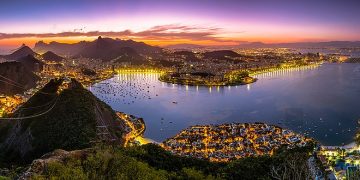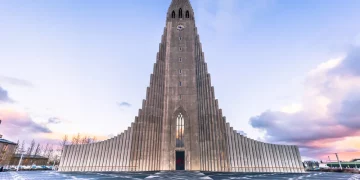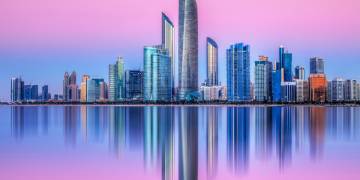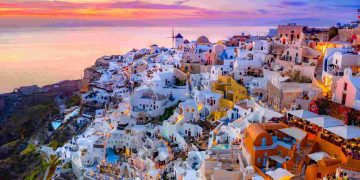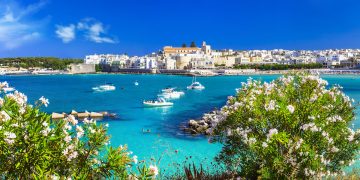India, a country of diverse cultures, languages, and religions, celebrates an array of festivals throughout the year. These festivals are more than just events; they are an embodiment of the nation’s rich history, vibrant traditions, and deep spiritual roots. Each festival in India is unique, with its own set of rituals, customs, and practices that reflect the values, beliefs, and joy of the people.
Among the many festivals that grace the Indian calendar, Diwali, the Festival of Lights, stands out as one of the most universally recognized. Celebrated by millions across the country and around the world, Diwali is not just a time for family reunions, elaborate feasts, and joyous gatherings, but also a deeply spiritual occasion that reflects the triumph of good over evil, light over darkness, and knowledge over ignorance.
However, India’s festivals go far beyond Diwali. Each region, religion, and community has its own set of festivals that hold significant cultural meaning, from the vibrant colors of Holi to the intricate rituals of Durga Puja, and the spiritual significance of Navaratri. Whether celebrated with grandeur or simplicity, Indian festivals are woven into the very fabric of everyday life, offering a beautiful and unforgettable glimpse into the country’s soul.
The Spiritual and Cultural Importance of Indian Festivals
The spiritual significance of Indian festivals cannot be overstated. At their core, these festivals offer an opportunity for reflection, growth, and connection to the divine. They provide a platform for people to come together, strengthening social ties and reinforcing the community spirit.
Many festivals have religious roots, often linked to Hinduism, Buddhism, Sikhism, and Islam, but they also embrace universal themes such as family, togetherness, and the acknowledgment of life’s blessings. The rituals associated with these festivals are steeped in symbolism—offering prayers, lighting lamps, ringing bells, and singing hymns—all contribute to a sense of harmony and purity that transcends material existence.
Through these festivals, Indians celebrate life in its various forms, honoring the changing seasons, the harvests, deities, or historical events that have shaped the nation’s identity. The way people celebrate can vary dramatically, with some communities focusing on ritualistic traditions, while others highlight festive joy, music, and dance.
Indian Festivals as Cultural Art Forms
Indian festivals also act as a platform for showcasing traditional art forms. From dance performances like Bharatanatyam and Kathak to classical music recitals and folk performances, every festival becomes an avenue for artists to display their skills. Similarly, the food culture during festivals is an essential part of the celebration. Sweets, savories, and traditional dishes are crafted with care and offered to guests, elevating the overall experience.
In addition to traditional practices, many festivals also include art forms such as rangoli (decorative patterns made with colored powders), painting, and sculpting. This fusion of ritual and artistic expression creates a lively, colorful, and aesthetically pleasing atmosphere, embodying the essence of India’s spiritual and cultural diversity.
Hot Spot: Best Places to Celebrate Diwali Across India
Diwali, the Festival of Lights, is arguably the most important and widely celebrated festival in India. Marking the triumph of good over evil, light over darkness, and hope over despair, Diwali is celebrated with great enthusiasm, family gatherings, firework displays, and an abundance of sweets. While Diwali is celebrated all over India, certain cities and regions are particularly known for their spectacular Diwali celebrations. These hotspots offer visitors a unique opportunity to witness and participate in one of India’s most vibrant festivals.
1. Varanasi – A Spiritual Diwali Experience
Varanasi, the ancient spiritual city located on the banks of the holy Ganges River, provides a Diwali experience like no other. Known for its spiritual significance and grand celebrations, Varanasi’s ghats are lit with thousands of diyas (oil lamps) during Diwali night, creating a breathtaking sight. The rituals performed here are deeply rooted in Hindu traditions, and the city offers a perfect blend of spirituality, culture, and festivity.
Diwali in Varanasi is not only about the lights but also the sacred fire rituals, prayers, and offerings to Goddess Lakshmi (the Goddess of wealth and prosperity). The ghats come alive with the sound of bells, chanting, and the fragrance of incense as devotees offer prayers to mark the occasion. Visitors can witness the beautiful illumination of temples, streets, and ghats, and participate in evening aarti ceremonies that provide a unique insight into Indian spiritual practices.
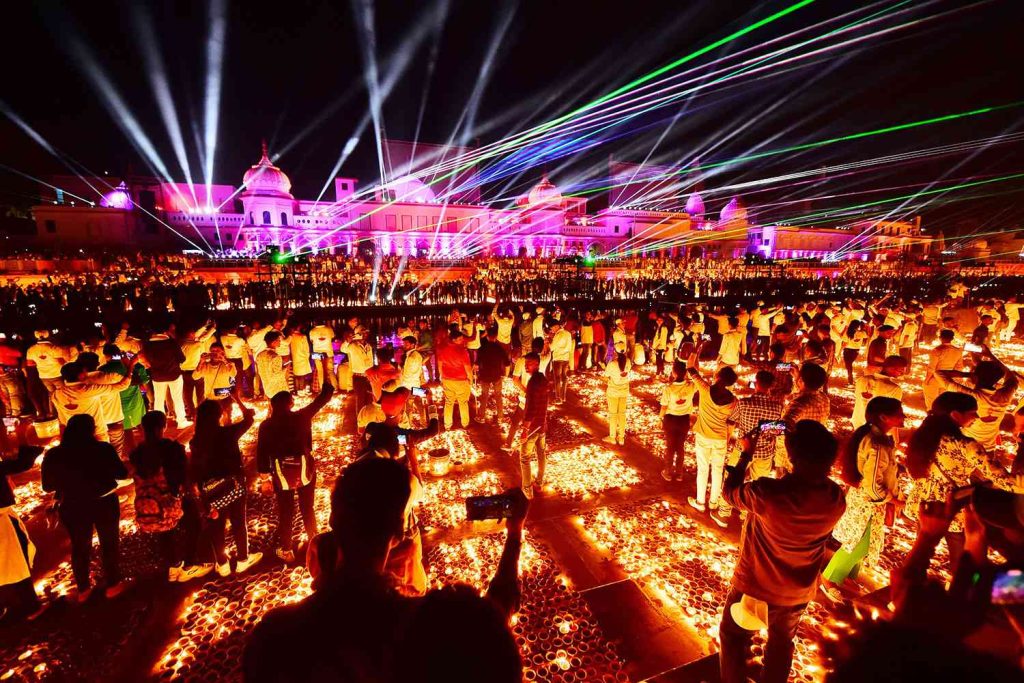
2. Jaipur – A Royal Diwali Celebration
Jaipur, also known as the “Pink City,” takes Diwali celebrations to another level, blending tradition with royal grandeur. Known for its majestic palaces, forts, and vibrant markets, Jaipur’s Diwali festivities feature stunning illuminations on iconic buildings such as the Hawa Mahal and Amer Fort. The city’s markets are adorned with colorful lights and rangoli, and the atmosphere is filled with joy and excitement.
One of the highlights of Diwali in Jaipur is the royal tradition of lighting the Jal Mahal (Water Palace) with thousands of lamps. The city’s lavish Laxmi Puja ceremony at the Govind Dev Ji Temple is another significant event, where people come together to worship and offer prayers to Goddess Lakshmi. Visitors can also enjoy traditional Rajasthani sweets and dhol dance performances during the celebrations.
3. Delhi – A City of Lights and Fireworks
Delhi, the capital of India, is known for its extravagant Diwali celebrations that illuminate the entire city. The Connaught Place and Chandni Chowk markets are famous for their Diwali shopping experience, with vibrant lights, colorful decorations, and a festive atmosphere. The grand firework displays in the evening sky are one of the highlights of Diwali in Delhi, and the entire city seems to come alive with the sound of crackers and laughter.
The Bangla Sahib Gurudwara and Jama Masjid are also known for their Diwali celebrations, where Sikhs and Muslims join together in harmony to light lamps and offer prayers. Visitors can experience both the religious and festive sides of Diwali, making it a truly diverse and inclusive celebration.
4. Mumbai – A Glittering Diwali Celebration by the Sea
Mumbai, India’s financial capital, is a city that never sleeps, and its Diwali celebrations are nothing short of spectacular. The streets are decorated with lights and rangoli, and markets like Zaveri Bazaar are filled with the buzz of people buying jewelry, sweets, and decorations for the festival. The famous Gateway of India and Marine Drive are beautifully illuminated, and the city’s skyline glows with colorful fireworks.
Mumbai also hosts several celebrity Diwali parties, which are attended by Bollywood stars and the city’s elite. For those looking to enjoy Diwali with a blend of glamour and tradition, Mumbai offers the perfect fusion of both worlds.
5. Amritsar – A Diwali Celebration at the Golden Temple
Amritsar, the spiritual capital of the Sikh faith, offers one of the most stunning Diwali experiences in India. The Golden Temple, the holiest site for Sikhs, is beautifully illuminated with thousands of lights, creating a mesmerizing sight. The temple’s complex is filled with prayers, hymns, and devotional music, offering a spiritual dimension to Diwali celebrations.
During Diwali, Sikhs celebrate Bandi Chhor Divas, a day that marks the release of Guru Hargobind Ji from imprisonment. The celebration in Amritsar includes a ceremonial procession, prayers, and fireworks. The combination of spirituality and festivity makes Amritsar a must-visit destination during Diwali.
Destination Guide: Hidden Gems to Experience India’s Vibrant Festivals
India’s festivals are celebrated across the country, from the bustling cities to remote villages, offering travelers a chance to experience both grandeur and simplicity. Some of India’s hidden gems offer intimate and off-the-beaten-path experiences of traditional festivals, where you can immerse yourself in local customs and celebrations. Here are some lesser-known places to experience India’s vibrant festivals:
1. Pushkar – The Camel Fair Festival
The Pushkar Camel Fair in Rajasthan is a unique festival that blends cultural heritage with a rural carnival atmosphere. Held annually in the town of Pushkar, this event attracts thousands of camel traders, farmers, and pilgrims. Visitors can witness camel races, traditional dance performances, folk music, and enjoy local Rajasthani cuisine.
Pushkar’s Brahma Temple is also a significant pilgrimage site, and the town’s serene Pushkar Lake provides a peaceful backdrop for the festivities. The fair is held in November, during the full moon, offering an unforgettable cultural experience.
2. Rishikesh – A Spiritual Retreat During Maha Shivaratri
Rishikesh, nestled in the foothills of the Himalayas, is a peaceful town known for yoga and spirituality. However, during Maha Shivaratri, it becomes a vibrant hub for devotees of Lord Shiva. The town’s ghats are adorned with flowers, and priests conduct evening aarti ceremonies that are both spiritual and mesmerizing. Travelers can participate in rituals, enjoy the serenity of the Ganges River, and explore the surrounding nature.
3. Gokarna – Celebrating Ganesh Chaturthi in Peace
While Ganesh Chaturthi is a major festival in cities like Mumbai, Gokarna, a quieter coastal town in Karnataka, offers a more intimate celebration. Gokarna’s temples are filled with devotees during the festival, who come to offer prayers to Lord Ganesha and take part in processions. The combination of temple rituals, beach serenity, and village traditions creates a unique atmosphere that’s perfect for those seeking a peaceful but still vibrant festival experience.
4. Khajuraho – The Dance Festival During Navaratri
Khajuraho, known for its UNESCO-listed temples, offers an enchanting experience of Navaratri celebrations. The Khajuraho Dance Festival is a cultural extravaganza that takes place during the Navaratri period, showcasing classical Indian dance performances from all over the country. The ancient temples, with their intricate sculptures, provide a stunning backdrop for the performances. The atmosphere is both serene and celebratory, offering a perfect blend of spirituality and art.
5. Makar Sankranti in Ahmedabad – The Kite Festival
Makar Sankranti is celebrated with great enthusiasm in Ahmedabad, Gujarat. The International Kite Festival held here is a vibrant and colorful celebration, where locals and visitors fly kites to mark the change of seasons. The skies are filled with thousands of colorful kites, creating a visual feast. The festival is also a time for sharing traditional foods like tilgul (sesame sweets) and dahi-chiwda (yogurt with rice flakes).
Conclusion
Indian festivals are not just about vibrant celebrations and rituals; they are windows into the soul of
the nation. They offer a deep connection to the country’s rich history, culture, and spiritual traditions. From the grandeur of Diwali to the intimate charm of hidden festivals, India provides a rich tapestry of experiences for anyone seeking to explore the magic of its rituals and celebrations.
Whether you’re planning to witness the extravagant Diwali celebrations in Varanasi or experience a quieter, more intimate celebration in a remote village, India’s festivals promise an unforgettable experience that will leave a lasting impression.



